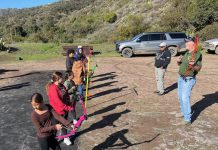The following is the second in a series on why the Catalina Island Conservancy was created, its unique history and mission.
The Catalina Island Conservancy uses the best ecological practices and leading-edge science to protect and restore Catalina’s wildlands while also welcoming the public to enjoy the Island’s rugged beauty.
The following is the second in a series on why the Catalina Island Conservancy was created, its unique history and mission.
The Catalina Island Conservancy uses the best ecological practices and leading-edge science to protect and restore Catalina’s wildlands while also welcoming the public to enjoy the Island’s rugged beauty.
“Ecosystems are remarkably resilient,” said Ann Muscat, Conservancy president and CEO. “Still, they need a helping hand. Science-based conservation and a lot of hard work and dedication can make a world of difference.”
“The Conservancy’s rigorous conservation and science program is extraordinary,” said Darla Guenzler, executive director of the California Council of Land Trusts. “The Conservancy has met critical wildlife challenges with cutting-edge science, hard work and dedication with proven results.”
Some highlights of the Conservancy’s efforts include:
Recovery of the Catalina Island Fox
An internationally recognized accomplishment of the Conservancy’s 41 years has been preventing the extinction of the Catalina Island fox. The largest endemic mammal on the Island was decimated to approximately 100 animals in 1999 by an outbreak of canine distemper virus. The Conservancy partnered with the Institute for Wildlife Studies (IWS) to save the species through a captive breeding program, vaccinations and wild population monitoring. At the end of 2012, scientists estimated that at least 1,502 foxes lived on Catalina.
Bald Eagles on Catalina Island
The DDT contamination that curtailed bald eagle propagation on Catalina and elsewhere is only a memory now. This spring, 11 eaglets have hatched in Island nests. These latest additions followed incrementally increased egg-laying and hatchlings since the groundbreaking “Easter Miracle” in 2007. That was when four bald eagles hatched for the first time on Catalina in 50 years without human assistance – the helping hands and artificial incubation formerly provided by IWS scientists. Seven active nests now exist on Catalina and approximately 20 to 25 adult bald eagles call the Island home.
Managing Non-Native Plants
The Conservancy’s Catalina Habitat Restoration and Improvement Program has worked to control the spread of invasive plants and restore areas cleared of weeds. CHIRP has been recognized for its successes by the California Invasive Plant Council. In 2012, CHIRP treated 2,046 populations of 57 invasive species, including 4,300 acres along 95 miles of roads.
Managing Non-Native Animals
Non-native animals are a big challenge for many conservation organizations, and no less for the Conservancy. They adversely impact native species and ecosystems. They often threaten native species, which haven’t had time to evolve defenses. Catastrophic decline and extinction are real possibilities.
The removal of the feral goats and pigs that roamed the Island for generations was a difficult and controversial decision. But it resulted in significant improvement to the Island’s ecological health. When Catalina began to recover from overgrazing in 2005, Catalina grass (Dissanthelium californicum), which was thought to be extinct, was rediscovered. In 2011, the stream orchid was discovered and Lyon’s pygmy daisy was rediscovered after decades of assumed extinction.
The Island’s non-native mule deer are managed by the Private Land Management Hunting Program administered by the California Department of Fish and Wildlife. Approximately 200 to 300 deer are taken annually by resident and guest hunters. In 2012 the deer population was estimated at 2,387.
The contraception program for bison, a majestic cultural icon of the Island, maintains a healthy herd while it lessens the grazers’ impacts on habitat.
Other Ongoing Programs
The Conservancy charts animal and plant distributions as well as physical structures on the Island with GIS maps that are available to Island partners and visiting scientists.
The Conservancy welcomes mainland biologists, geologists, archaeologists and other scientists, and their students – more than 100 individuals came to Catalina in 2012 for 18 scientific investigations. The Conservancy also initiates new studies, including recent work with the Scripps’s murrelet population. Breeding nests were found on the Island in 2012 for the first time since one was recorded offshore on Bird Rock in 1967.
“The Catalina landscape is vast and careful decisions must be made to apply our limited resources to prioritize for the highest conservation results,” said John Mack, the chief conservation and education officer of the Conservancy. The Conservancy has an outstanding and dedicated conservation staff that are keenly focused on the stewardship of these unique ecosystems.”










